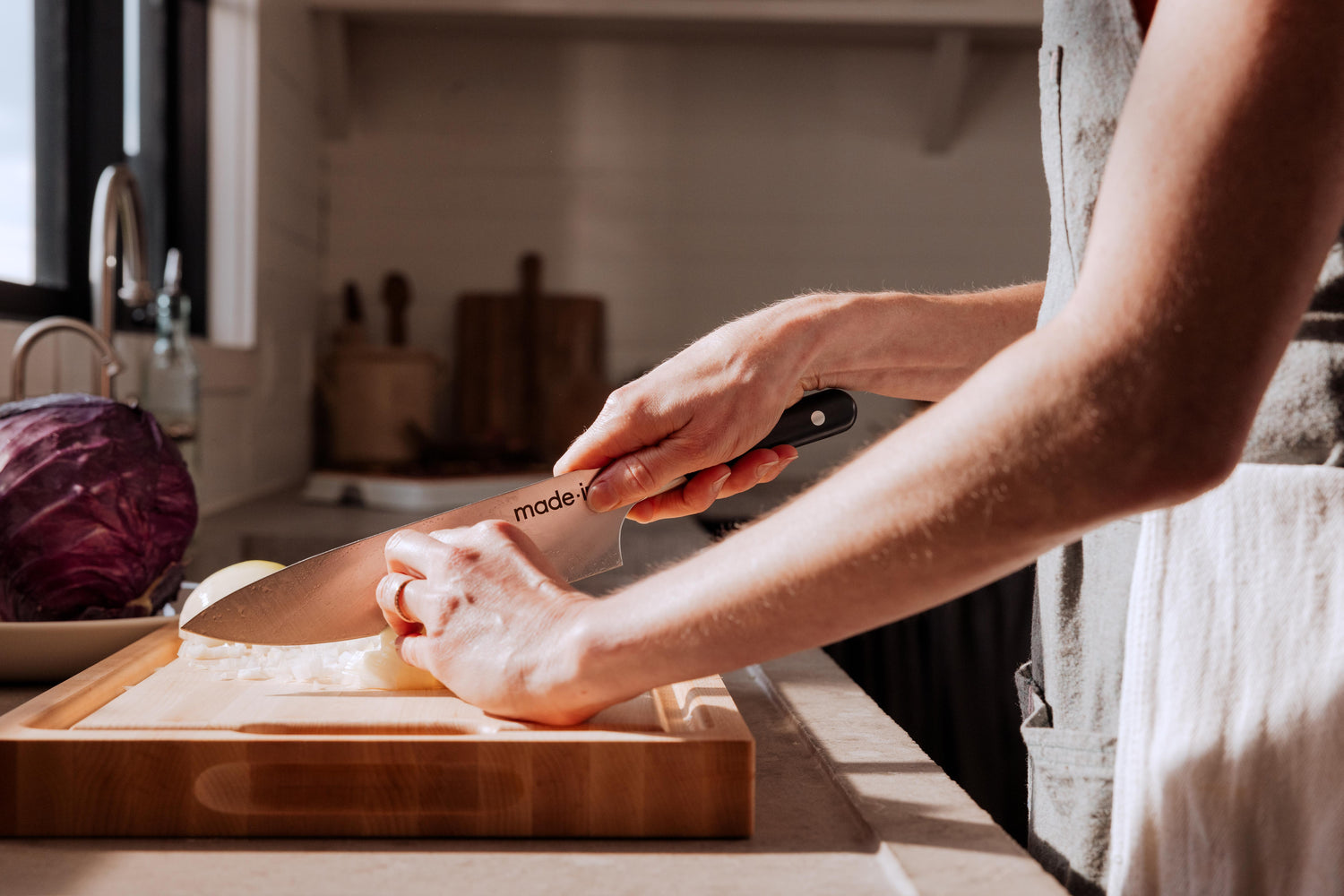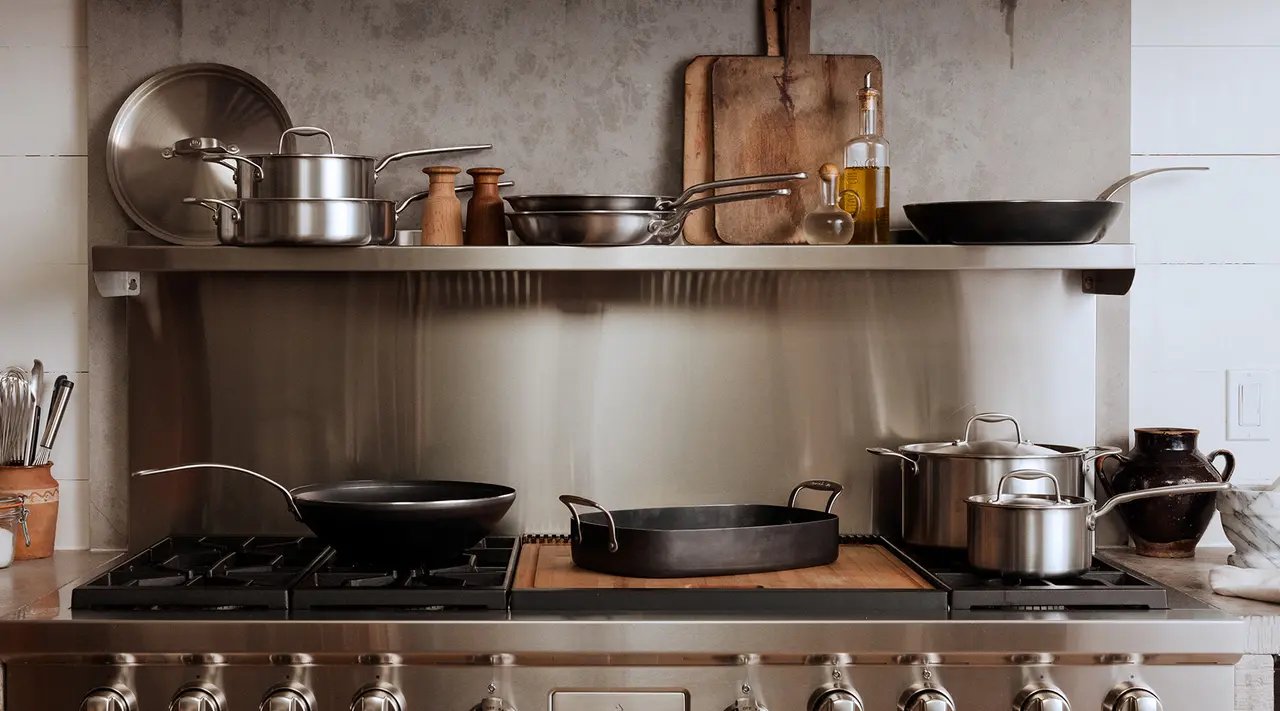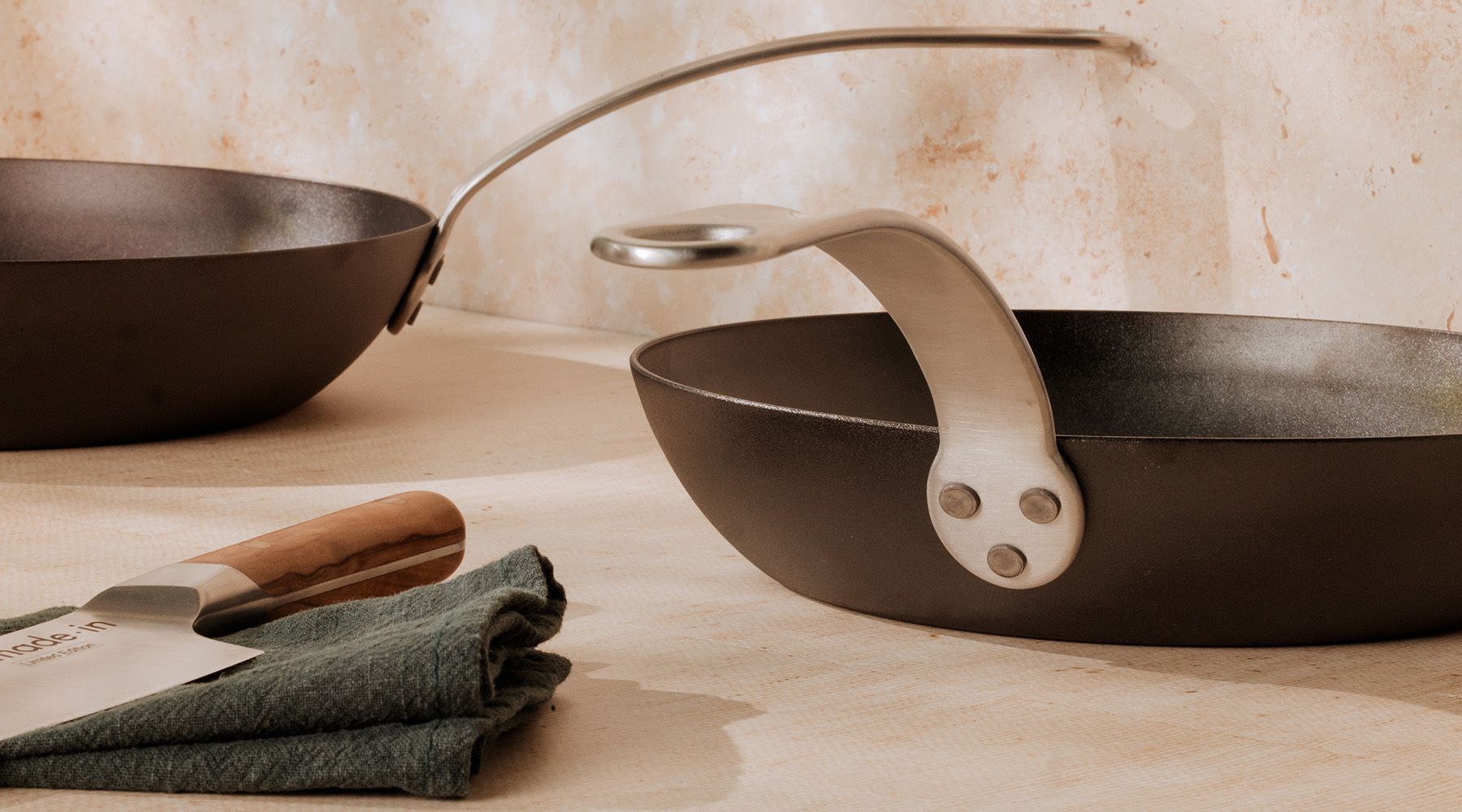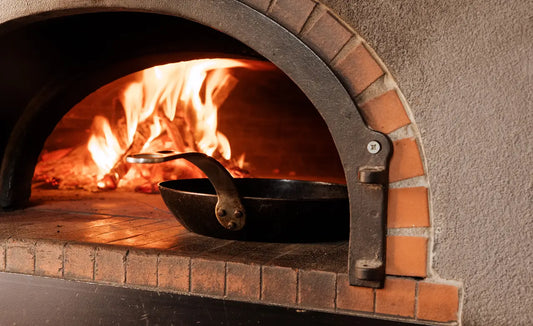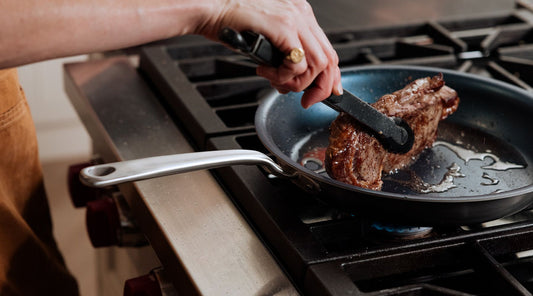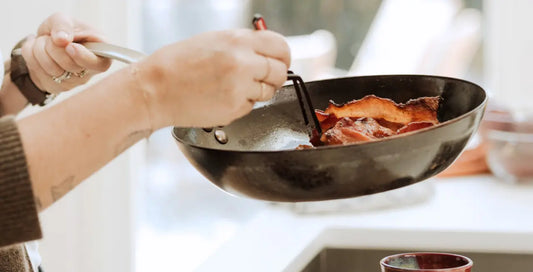Carbon steel is one of our favorite cookware materials. As a staple in professional kitchens that's beloved by French chefs, it's rapidly becoming more popular in home kitchens around the world. It isn’t hard to see why—carbon steel provides the best of both worlds of cast iron and stainless steel.
We’ve written at length on proper seasoning technique, the differences between carbon steel and cast iron, and a myriad of other topics related to one of our favorite cookware materials of all time, knowing that once you learn how to cook with and care for it, we’re sure it’ll be your new favorite piece of cookware.
In this care guide, we’ve put together all of the essentials: from how to clean your carbon steel pan after every use to what to do in the event of rust (first tip: don’t panic!). Here’s everything you need to keep your pan in stellar shape.
Understanding Carbon Steel Pans

Outside of running it over with your car, there’s not much you can do that would permanently ruin carbon steel cookware. Just like cast iron, these pieces are incredibly hardy and virtually impossible to ruin.
Made of a single piece of heavy-duty carbon-iron alloy (99% iron, 1% carbon), carbon steel pans can stand up to roaring high temperatures—ours is safe up to 1200F—and resist warping and denting. And since carbon steel pans are known for their heat retention abilities, they’re excellent at everything from oven roasting to searing and stir-frying. They’ve been tested on all manner of stovetops (including induction), on the grill, in the oven, and even over open flame, with the same exceptional result every time.
Plus, at roughly half as much as cast iron, carbon steel makes it way easier to flip crepes, toss vegetables, and transfer your pan from stove to oven.
How to Season Your Carbon Steel Pan
Just like with unfinished cast iron, having a properly seasoned carbon steel pan is essential. Seasoning is as simple as heating a thin coating of high smoke-point cooking oil in your pan to create polymerization, which is when the oil and heat form a solid layer that fills the metal’s small pores. This doesn’t just make your pan effectively non stick—it also protects your pan from oxidation, which is the main culprit of rust.
There are two main ways to season your carbon steel pan, whether it’s the initial seasoning layer or a periodic reseasoning—the oven or the stovetop. Note that if you opted for our Seasoned Carbon Steel Pans over unseasoned, then you can skip the initial seasoning, but all carbon steel will need to be reseasoned eventually.
How to Season Your Pan in the Oven
- Preheat your oven. The temperature should be the same as your oil’s smoke point: grapeseed oil, for example, has a smoke point of around 420F.
- Scrub your pan clean and dry it completely.
- Line a sheet with aluminum foil and place it on the bottom rack of your oven. This will catch any oil drips.
- Once your oven has fully preheated, place your clean, dry carbon steel pan on the stove over a low flame. Add a few drops of a neutral, high smoke point oil (such as grapeseed) or seasoning wax to your pan, then use a dish towel or paper towel to rub the oil evenly all over the inside of the pan.
- Remove your pan from the heat, then transfer to the oven.
- After an hour, turn off the oven and allow your pan to cool completely before removing it.
For more information on seasoning—and how to season your pan entirely on the stove—check out our in-depth guide. No matter how well you season your pan in the beginning, however, you’ll probably need to do a little reseasoning at some point.
This is normal—especially if you cook with acidic ingredients like wine or tomatoes, or accidentally scrub your pan a little too harshly. Here’s a step-by-step guide to stripping and reseasoning your carbon steel pan, as well as how to keep your seasoning intact.
How to Cook With Carbon Steel

Here are a few things to keep in mind when cooking with carbon steel, especially if you’re doing so for the first time.
- Before you put your pan on the stove, you should make sure your food is tempered (or as close to room temperature as possible). Putting cold food in a hot pan may cause thermal shock at worst or take a long time to heat up at best.
- Preheat your pan over medium-low heat for 2-3 minutes before cooking. After your pan has preheated, add your oil or butter, and let that heat in the pan for 1-2 minutes. After that, you should add your food. Remember not to overcrowd the pan—this can cause steaming, which will stop your food from achieving a crispy Maillard reaction.
- While carbon steel can get ripping hot, it’s often not necessary to go higher than medium-high heat, as this will still allow you to achieve perfect sears on your steaks and other proteins.
- You’ll want to avoid delicate foods like fish or eggs with a freshly seasoned carbon steel pan. With each use, the oil and fat from the food you cook will incorporate into your existing seasoning and help develop a slick patina. Start with proteins and food high in fat, like bacon, to kick-start the best possible naturally non stick surface.
How to Clean Your Carbon Steel Pan
Much like cleaning a cast iron skillet, you’ll want to avoid using dish soap on your carbon steel pan, since it can damage the seasoning. For a standard cleaning, you won’t need to do much— simply wipe out any remaining food and oil with a dish towel, paper towel, or microfiber cloth.
Method One: Wipe Your Pan Out
If your pan has been seasoned and used properly, then cleaning it it’s actually as easy as using a paper or kitchen towel to wipe out any excess oil. Thanks to its patina, it should look as good as new in practically no time.
However, for more stubborn messes, progress to the following step.
Method Two: Coarse Salt and Oil
- Add 2 tablespoons of coarse salt and 2 tablespoons of a neutral oil, like canola oil, vegetable oil, or grapeseed oil, to your cooled pan.
- Use a paper or kitchen towel to rub the salt and oil around its surface.The friction of the salt rubbing against the pan will free up any stubborn food bits.
- Dump the salt, oil, and leftover food from the pan into the sink, and wipe up any leftover residue with a clean paper or kitchen towel.
Method Three: Bring Water to a Boil
This trick is best used for any stubborn stuck-on residue or burnt food that won’t come off the surface of your pan.
- Add a small amount of warm water, just enough water to cover the bottom of your pan and bring it to a boil over medium heat.
- Once the water in your pan has reached a boil, use a Wooden Spoon or rubber spatula to carefully scrape at the food bits.
- Once all the food is free from the surface, dump the water in the sink. Return your pan to the burner over medium heat to completely dry your pan in order to prevent rusting.
- Apply a thin layer of canola or grapeseed oil to the surface of the pan. Let the pan sit on the burner for one minute. Your pan is now clean, re-seasoned, and ready for use.
Method Four: Use Steel Wool
If none of these methods have worked so far, then it’s time to break out the steel wool. We recommend gently scrubbing the areas of your pan containing stuck food bits with steel wool to remove them.
While this can cause superficial scratches on the surface, they will fill in thanks to the patina that develops the more you season and use your Pan. It’s essential to reseason your pan after this, as the steel wool will strip the preexisting seasoning.
In some cases, this method may not be enough. If you’re dealing with serious messes, get further details in our comprehensive guide to cleaning carbon steel.
How to Store Carbon Steel Pans
Now that you know how to clean and season your carbon steel, you’re officially in the home stretch. But don’t just hang up your dripping wet frying pan—because carbon steel has a high iron content, even a well-seasoned pan can get rusty if you put it away wet, or keep it in a humid environment. That’s why we recommend drying your pan on the stove after wiping it dry. Simply place your pan on the burner over low heat for a few minutes, then remove from the heat and allow to cool before putting it away.
Along with getting your pan nice and dry before storing it, we also recommend hanging it up instead of stacking it with other cookware items. If you do choose to stack, make sure to lay a dish towel or trivet inside your pan before placing another piece of cookware on top: this keeps the seasoning from getting scratched up.
Troubleshooting Common Issues
Preventing issues like rust or patchy seasoning is easy enough, but what do you do if it’s too late? Rest assured that there’s nearly always a fix, no matter what issue you’re facing. Here are some of the most common ones.

Damaged Seasoning
If your food is starting to stick a little more than it normally does, or you’re starting to notice the bare metal of your pan showing through the layers of black seasoning, it’s probably time to reseason it.The good news? This is pretty much exactly the same process as seasoning your brand new carbon steel pan. The bad news? You’ll have to start pretty much from scratch.
Note that acidic ingredients like citrus, wine, tomatoes, and vinegar can strip away the patina that you’ve built up in your pan. We suggest using our wide variety of Stainless Clad Cookware if what you’re cooking calls for these ingredients.
However, using acidic foods in your carbon steel pan won’t ruin it beyond repair. If you do end up cooking with acidic foods and notice the seasoning strip away, don’t worry, as your pan is still perfectly healthy and safe. You’ll just need to reseason your pan using the stovetop or oven method.
Dried Out Surface
A dried out surface can occur if you haven’t used your pan for an extended period of time. If you know you aren’t going to be reaching for this pan especially often, make sure to apply a thin layer of oil to the surface every now and again to keep it from drying out.
If you notice that your cookware is dried out, refer back to either of the two seasoning methods mentioned above. You can also choose to cook naturally fattier foods, like bacon or steak, to help add some grease to the pan.
Rusty Pans
Rust can develop on the surface of your pan if you live in a particularly humid climate, the pan wasn’t dried thoroughly before storing, or if it hasn’t been seasoned properly. Here are a couple of our favorite methods for removing rust, both of which involve stripping most, if not all, of your pan’s seasoning and starting over.
Splotchy or Uneven Seasoning
Carbon steel will take on a variety of colors and patterns as you begin to season and cook with your pan. As you continue to use your pan, these patterns can change, darken, and begin to even out.
If you feel like your pan is “ugly” or the seasoning layer looks uneven, know that this is a normal part of the process. It is important to remember that your Carbon Steel should be defined by how it cooks, rather than its appearance. If you want your pan to adopt a more uniform appearance, it would be best to cook with fattier foods to build up an even patina.
Sticky Surface
If your pan feels sticky or tacky to the touch, you may have overseasoned it. This typically happens when you add too much oil during the seasoning process, and will typically even out naturally as you continue to use your pan. If it doesn’t, you may need to reseason it.
If you're facing a differnet problem, check out some of our most frequently asked carbon steel-related questions, answered.
Ready to Cook?
Now you’re fully primed and ready to start cooking with—and caring for—your carbon steel cookware. All that’s left for you to do is decide what to cook first.

